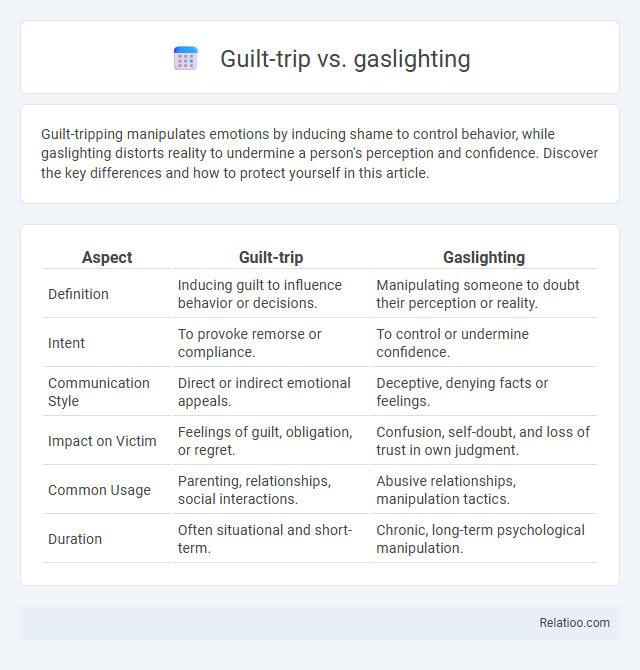Guilt-tripping manipulates emotions by inducing shame to control behavior, while gaslighting distorts reality to undermine a person's perception and confidence. Discover the key differences and how to protect yourself in this article.
Table of Comparison
| Aspect | Guilt-trip | Gaslighting |
|---|---|---|
| Definition | Inducing guilt to influence behavior or decisions. | Manipulating someone to doubt their perception or reality. |
| Intent | To provoke remorse or compliance. | To control or undermine confidence. |
| Communication Style | Direct or indirect emotional appeals. | Deceptive, denying facts or feelings. |
| Impact on Victim | Feelings of guilt, obligation, or regret. | Confusion, self-doubt, and loss of trust in own judgment. |
| Common Usage | Parenting, relationships, social interactions. | Abusive relationships, manipulation tactics. |
| Duration | Often situational and short-term. | Chronic, long-term psychological manipulation. |
Understanding Guilt-Tripping: Definition and Examples
Guilt-tripping involves manipulating someone by inducing feelings of guilt to influence their behavior, often through statements that highlight perceived shortcomings or responsibilities. Examples include phrases like "After all I've done for you, this is how you repay me?" which exploit emotional leverage to prompt compliance or apology. Understanding guilt-tripping is crucial for recognizing emotional manipulation distinct from gaslighting, which targets a person's perception of reality rather than their sense of guilt.
What is Gaslighting? Key Characteristics
Gaslighting is a psychological manipulation tactic where the abuser makes the victim doubt their reality, memory, or perceptions, often causing confusion and emotional dependency. Key characteristics include persistent lying, denying facts despite clear evidence, and projecting blame onto the victim to destabilize their sense of self. Unlike guilt-tripping, which leverages guilt to influence behavior, gaslighting aims to erode the victim's confidence and control their thoughts and feelings over time.
Core Differences: Guilt-Trip vs Gaslighting
Guilt-tripping involves inducing feelings of guilt to manipulate behavior, while gaslighting distorts reality to make victims doubt their perceptions and sanity. The core difference lies in guilt-tripping targeting emotions through moral pressure, whereas gaslighting undermines a person's belief in their own experiences and memory. Understanding these distinct manipulation tactics is essential for recognizing and addressing emotional abuse effectively.
Psychological Impact on Victims
Guilt-tripping and gaslighting both inflict significant psychological harm, but through different mechanisms: guilt-tripping induces feelings of shame and self-blame, undermining victims' self-esteem, while gaslighting erodes reality perception, causing confusion and anxiety. Repeated exposure to guilt-tripping often results in heightened stress and lowered self-worth, whereas gaslighting can lead to depression and chronic self-doubt. The psychological impact of these manipulative tactics may overlap, yet gaslighting uniquely destabilizes cognitive trust, profoundly impairing emotional resilience.
Common Signs of Guilt-Tripping
Common signs of guilt-tripping include persistent reminders of past favors, exaggerated portrayals of sacrifice, and manipulation through emotional appeals to induce feelings of obligation or shame. Unlike gaslighting, which distorts reality to make the victim doubt their perception, guilt-tripping directly targets emotions by leveraging guilt to control behavior. Recognizing these tactics is essential for maintaining healthy boundaries and emotional well-being.
Recognizing Gaslighting Tactics
Recognizing gaslighting tactics involves identifying manipulative behaviors where the abuser distorts reality to make the victim doubt their perception, memory, or sanity. Unlike guilt-tripping, which leverages shame to induce compliance, gaslighting systematically erodes self-trust and emotional stability through denial, contradiction, and blame-shifting. Understanding these distinctions helps victims accurately label emotional abuse and seek appropriate support or intervention.
How Guilt-Tripping Manifests in Relationships
Guilt-tripping in relationships manifests through persistent reminders of past mistakes, exaggerated emotional responses, or indirect accusations that induce feelings of shame and obligation. Unlike gaslighting, which distorts reality to make someone doubt their perception, guilt-tripping leverages emotional manipulation to control behavior by exploiting empathy and conscience. Recognizing the specific patterns of guilt-tripping, such as setting unrealistic expectations or withholding affection to provoke remorse, is crucial to maintaining healthy interpersonal dynamics.
Long-term Consequences of Gaslighting
Gaslighting manipulates your perception of reality, leading to long-term psychological damage such as anxiety, depression, and diminished self-esteem. Unlike guilt-tripping, which induces temporary remorse or regret, gaslighting erodes your ability to trust your own memories and judgments over time. The persistent nature of gaslighting can result in chronic emotional trauma, impairing your mental health and interpersonal relationships for years.
Strategies for Responding to Manipulation
Recognizing the differences between guilt-tripping, gaslighting, and shaming is crucial for effective response strategies. Setting firm boundaries, maintaining clarity of personal truth, and seeking external support help counteract manipulation tactics. Employing assertive communication and documenting interactions can also empower individuals to protect mental health and dismantle manipulative behavior.
Seeking Help: Support and Recovery Options
Seeking help for guilt-trips and gaslighting involves recognizing the psychological manipulation that undermines your self-esteem and trust. Support options include therapy with licensed mental health professionals specializing in emotional abuse, support groups that provide shared experiences and coping strategies, and educational resources to understand manipulation tactics. Recovery efforts focus on rebuilding your confidence, setting healthy boundaries, and developing resilience against future emotional abuse.

Infographic: Guilt-trip vs Gaslighting
 relatioo.com
relatioo.com